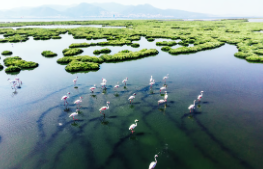Wetlands Vital in Global Biodiversity Strategies
The UN Biodiversity Conference is currently underway in Cali, Colombia. A recent assessment by 35 percent ltd, commissioned by Wetlands International, marks the importance of wetlands in National Biodiversity Strategies and Action Plans (NBSAPs). This assessment follows COP15, where nations were urged to revise their biodiversity plans in line with the Kunming-Montreal Global Biodiversity
Framework (KMGBF).
Importance of Wetlands
Wetlands are vital ecosystems. They provide essential services such as:Protecting and improving water quality.
Wetlands are vital ecosystems. They provide essential services such as:Protecting and improving water quality.
- Providing habitats for wildlife.
- Storing floodwaters.
- Maintaining surface water flow during dry periods.
NBSAPs and Wetland Inclusion
Wetlands International’s report, titled Assessing the Inclusion of Wetlands in NBSAPs, reviews how well wetlands are represented in these crucial documents. The analysis includes 24 NBSAPs from 196 countries that are parties to the Convention on Biodiversity. The majority of submissions came from Europe, followed by Asia, Africa, North America, Latin America, the Caribbean, and Oceania.
Wetlands International’s report, titled Assessing the Inclusion of Wetlands in NBSAPs, reviews how well wetlands are represented in these crucial documents. The analysis includes 24 NBSAPs from 196 countries that are parties to the Convention on Biodiversity. The majority of submissions came from Europe, followed by Asia, Africa, North America, Latin America, the Caribbean, and Oceania.
Key Findings
The report revealed several important findings:
The report revealed several important findings:
- 83 percent of submitted NBSAPs explicitly mention wetlands, inland waters, or freshwater.
- 100 percent of submissions from Africa and Oceania included these terms.
- Over 90 percent of European nations mentioned wetlands.
- 71 percent of plans articulate specific measures for restoration (Target 2).
- 50 percent include protections for wetlands (Target 3).
Specific Wetland Types
The review identified 16 NBSAPs that mentioned specific wetland types, including Mangroves, Rivers, Lakes, Peatlands Mangroves, rivers, and lakes were the most frequently mentioned, indicating their significance for environmental targets. However, major wetland areas like the Amazon River Basin and Hudson Bay Lowland were rarely addressed in national strategies. This oversight is concerning given their importance for biodiversity and climate regulation.
The review identified 16 NBSAPs that mentioned specific wetland types, including Mangroves, Rivers, Lakes, Peatlands Mangroves, rivers, and lakes were the most frequently mentioned, indicating their significance for environmental targets. However, major wetland areas like the Amazon River Basin and Hudson Bay Lowland were rarely addressed in national strategies. This oversight is concerning given their importance for biodiversity and climate regulation.
Need for Improvement
The report stresses the need for countries to better integrate wetlands into their biodiversity targets. Specific, measurable goals for wetland restoration and protection are essential. Focusing on key wetland areas will enhance regional and global ecological health.
This assessment serves as a wake-up call for nations worldwide. The importance of wetlands in achieving biodiversity goals cannot be overstated. As COP16 begins, countries must take bolder actions to conserve these ecosystems. This will benefit both nature and the communities that depend on them.




Comments
Post a Comment